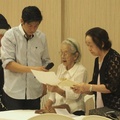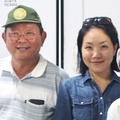"Can I participate in the Bon Odori again this year?" I received a call from the president of the women's association, and realized that a year had passed since then. Last year, only about two weeks after I was assigned to Belem, I was invited to the summer festival and participated. I had no idea how long it would take to get there, what events would be held, or how many people would participate, but I was taken to the venue and was a part of the Bon Odori circle the whole time. I also remember that there were so many participants that I felt the size of the Japanese community in Brazil. In Mexico, where I used to live, many people participated in the Mother's Day party, which is a major event, and it was very lively, but it goes without saying that the situation is different in Mexico, where the number of Japanese people is 20,000, and Brazil, where the number is 1.6 million (as of 2014, according to the "Japan Association of Japanese Overseas" website).
The summer festival has been held every year since the mid-1980s. It is a big event that brings together people of all ages and genders with the aim of spreading Japanese culture, raising funds for the cultural association, and building friendships among members. The paper flowers used for decorations, the buns, pickles, and bento boxes sold are all handmade by members of the women's association. Pictures drawn by students from the Japanese language school are used for the lanterns. What surprised me was that the signs and all the decorations are made every year. Due to the hot and very humid climate, if they are stored, the colors will change and mold will grow.
In the second half of the morning Japanese language school class, all students except for preschoolers help with the preparations for the festival with the teacher. Not a single child is unwilling. Junior high school boys climb ladders to light the lanterns. Elementary school students help them. Girls wrap tape around the pillars of the tower. The roles are naturally divided. When we go to the community center, many members of the women's association are making items to sell in the kitchen, and it is very lively. Lunch is also prepared there, so we stop preparing and eat it together. In this way, everyone has been making the festival every year for over 30 years. Through the events, "Japan" is passed down from adults to children. Laughter echoes around one table. They have lived in this society since they were young, and gather whenever something is held. In the words of the teacher, "we are all like a family."
On such occasions, they have always felt a connection with each other. I think it was a way for them to feel a connection to Japan, and also a way for them to confirm their own identity. This confirmation by each individual is closely related to the survival of the Japanese community. For those who belong to it to be conscious of their roots, it is very important for the Japanese community to continue to exist as a "Japanese" community. The existence of the Japanese community is also an asset to Brazilian society. Many Japanese people have become politicians, doctors, university professors and so on, and are active in Brazilian society. This contributes to strengthening relations between Brazil and Japan politically, economically and culturally, and can be said to be beneficial for Japan as well.
As a Japanese teacher in Brazil, I often hear the term "Heritage Japanese Language Education." This refers to Japanese language education that is taught to Japanese descendants with the goal of passing on Japanese culture in general, including the Japanese language. Preparing for a summer festival as part of Japanese language classes is a perfect example of this. By not only participating in a cultural event like the summer festival, but by having each student involved from the preparation stage onwards, each student feels a connection to Japan, and this feeling is passed down from parent to child, and from child to grandchild. This is how the future of the Japanese community is shaped, becoming a social resource for Brazil and leading to the development of Japanese society.
Unlike last year, when I joined the festival from the start and simply danced within the Bon Odori circle, this year, I was able to join in the preparation period and it felt like I was dancing within the circle of the Japanese community at the second summer festival.
© 2015 Asako Sakamoto








